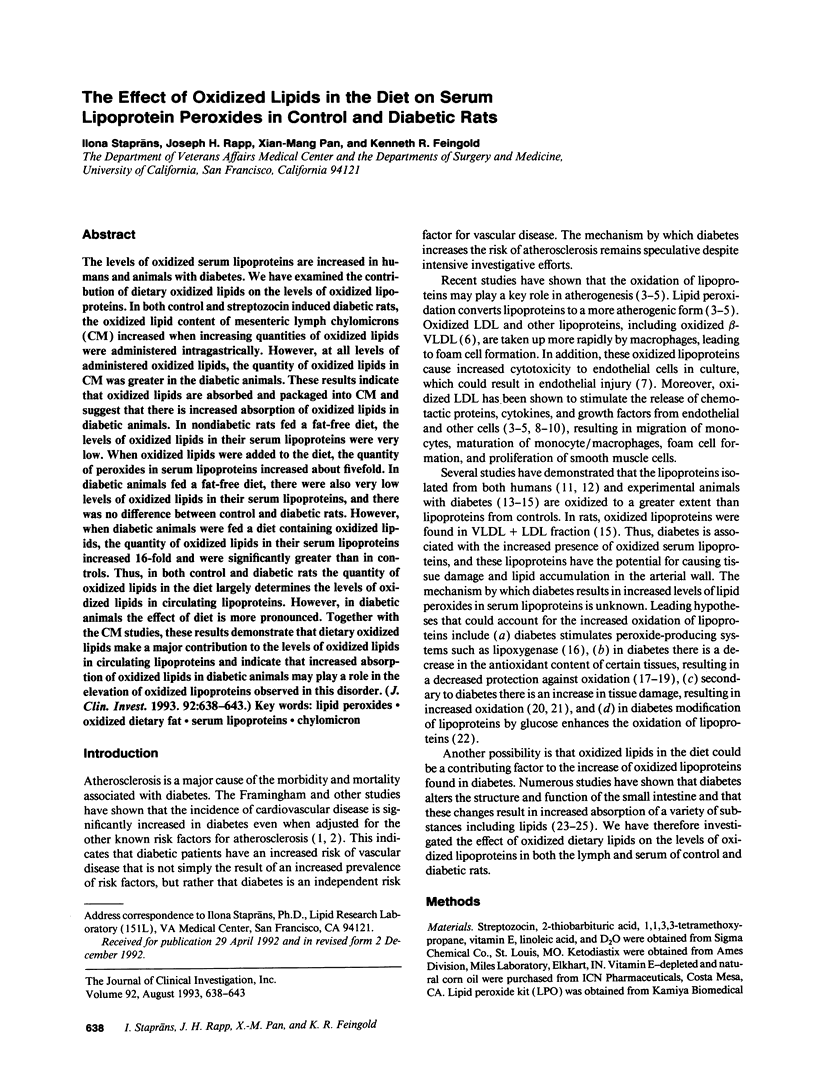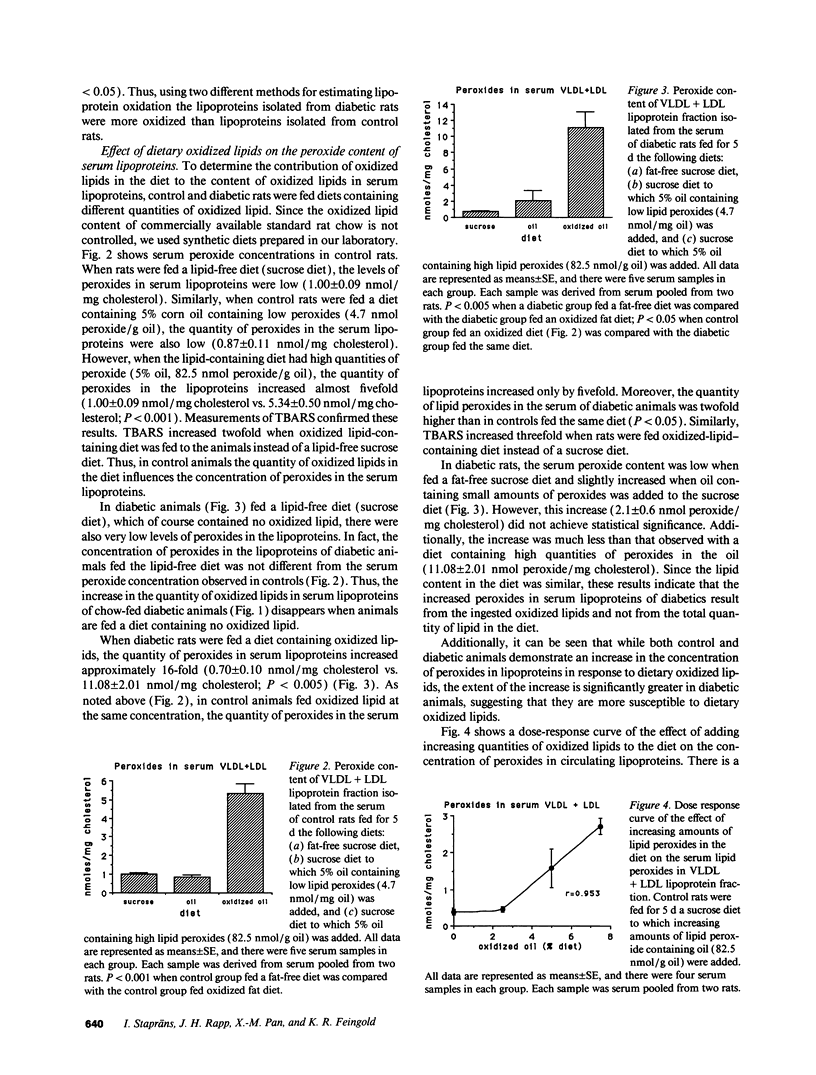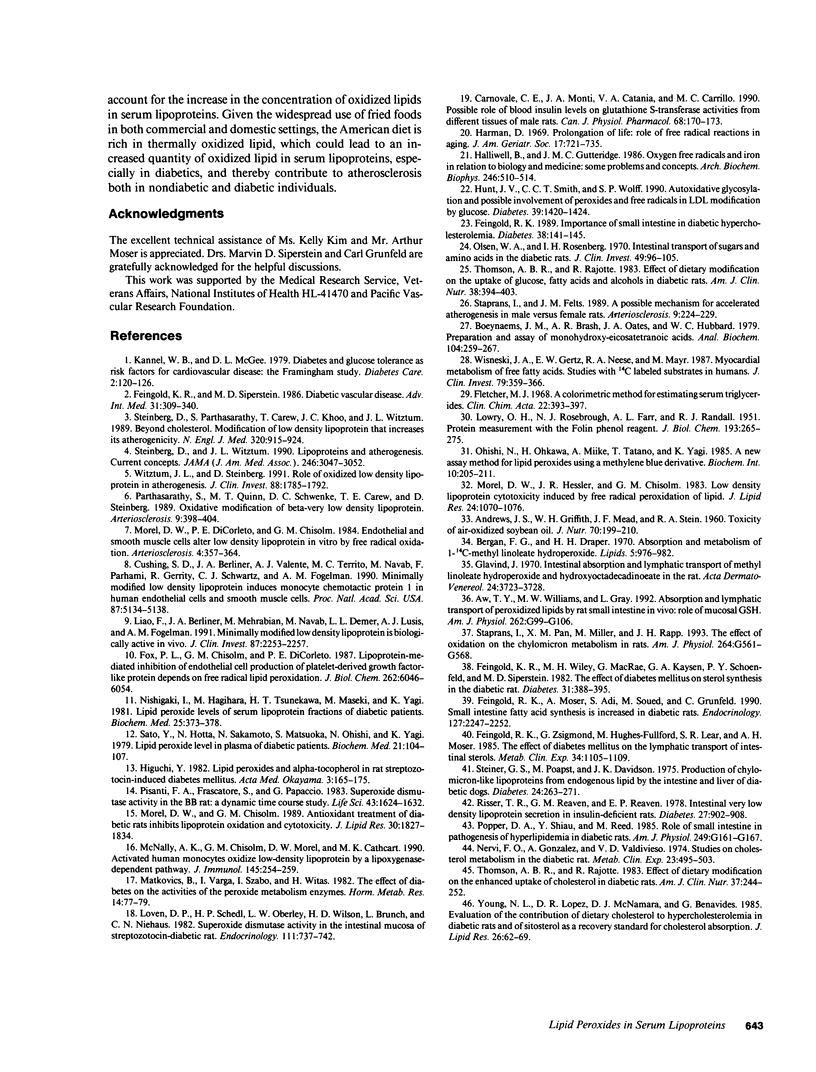Abstract
The levels of oxidized serum lipoproteins are increased in humans and animals with diabetes. We have examined the contribution of dietary oxidized lipids on the levels of oxidized lipoproteins. In both control and streptozocin induced diabetic rats, the oxidized lipid content of mesenteric lymph chylomicrons (CM) increased when increasing quantities of oxidized lipids were administered intragastrically. However, at all levels of administered oxidized lipids, the quantity of oxidized lipids in CM was greater in the diabetic animals. These results indicate that oxidized lipids are absorbed and packaged into CM and suggest that there is increased absorption of oxidized lipids in diabetic animals. In nondiabetic rats fed a fat-free diet, the levels of oxidized lipids in their serum lipoproteins were very low. When oxidized lipids were added to the diet, the quantity of peroxides in serum lipoproteins increased about fivefold. In diabetic animals fed a fat-free diet, there were also very low levels of oxidized lipids in their serum lipoproteins, and there was no difference between control and diabetic rats. However, when diabetic animals were fed a diet containing oxidized lipids, the quantity of oxidized lipids in their serum lipoproteins increased 16-fold and were significantly greater than in controls. Thus, in both control and diabetic rats the quantity of oxidized lipids in the diet largely determines the levels of oxidized lipids in circulating lipoproteins. However, in diabetic animals the effect of diet is more pronounced. Together with the CM studies, these results demonstrate that dietary oxidized lipids make a major contribution to the levels of oxidized lipids in circulating lipoproteins and indicate that increased absorption of oxidized lipids in diabetic animals may play a role in the elevation of oxidized lipoproteins observed in this disorder.
Full text
PDF





Selected References
These references are in PubMed. This may not be the complete list of references from this article.
- ANDREWS J. S., GRIFFITH W. H., MEAD J. F., STEIN R. A. Toxicity of air-oxidized soybean oil. J Nutr. 1960 Feb;70:199–210. doi: 10.1093/jn/70.2.199. [DOI] [PubMed] [Google Scholar]
- Bergan J. G., Draper H. H. Absorption and metabolism of 1-14C-methyl linoleate hydroperoxide. Lipids. 1970 Dec;5(12):976–982. doi: 10.1007/BF02533200. [DOI] [PubMed] [Google Scholar]
- Boeynaems J. M., Brash A. R., Oates J. A., Hubbard W. C. Preparation and assay of monohydroxy-eicosatetraenoic acids. Anal Biochem. 1980 May 15;104(2):259–267. doi: 10.1016/0003-2697(80)90073-1. [DOI] [PubMed] [Google Scholar]
- Carnovale C. E., Monti J. A., Catania V. A., Carrillo M. C. Possible role of blood insulin levels on glutathione S-transferase activities from different tissues of male rats. Can J Physiol Pharmacol. 1990 Feb;68(2):170–173. doi: 10.1139/y90-027. [DOI] [PubMed] [Google Scholar]
- Cushing S. D., Berliner J. A., Valente A. J., Territo M. C., Navab M., Parhami F., Gerrity R., Schwartz C. J., Fogelman A. M. Minimally modified low density lipoprotein induces monocyte chemotactic protein 1 in human endothelial cells and smooth muscle cells. Proc Natl Acad Sci U S A. 1990 Jul;87(13):5134–5138. doi: 10.1073/pnas.87.13.5134. [DOI] [PMC free article] [PubMed] [Google Scholar]
- Feingold K. R. Importance of small intestine in diabetic hypercholesterolemia. Diabetes. 1989 Feb;38(2):141–145. doi: 10.2337/diab.38.2.141. [DOI] [PubMed] [Google Scholar]
- Feingold K. R., Moser A., Adi S., Soued M., Grunfeld C. Small intestinal fatty acid synthesis is increased in diabetic rats. Endocrinology. 1990 Nov;127(5):2247–2252. doi: 10.1210/endo-127-5-2247. [DOI] [PubMed] [Google Scholar]
- Feingold K. R., Siperstein M. D. Diabetic vascular disease. Adv Intern Med. 1986;31:309–340. [PubMed] [Google Scholar]
- Feingold K. R., Wiley M. H., MacRae G., Moser A. H., Lear S. R., Siperstein M. D. The effect of diabetes mellitus on sterol synthesis in the intact rat. Diabetes. 1982 May;31(5 Pt 1):388–395. doi: 10.2337/diab.31.5.388. [DOI] [PubMed] [Google Scholar]
- Feingold K. R., Zsigmond G., Hughes-Fulford M., Lear S. R., Moser A. H. The effect of diabetes mellitus on the lymphatic transport of intestinal sterols. Metabolism. 1985 Dec;34(12):1105–1109. doi: 10.1016/0026-0495(85)90154-4. [DOI] [PubMed] [Google Scholar]
- Fletcher M. J. A colorimetric method for estimating serum triglycerides. Clin Chim Acta. 1968 Nov;22(3):393–397. doi: 10.1016/0009-8981(68)90041-7. [DOI] [PubMed] [Google Scholar]
- Fox P. L., Chisolm G. M., DiCorleto P. E. Lipoprotein-mediated inhibition of endothelial cell production of platelet-derived growth factor-like protein depends on free radical lipid peroxidation. J Biol Chem. 1987 May 5;262(13):6046–6054. [PubMed] [Google Scholar]
- Glavind J., Sylvén C. Intestinal absorption and lymphatic transport of methyl linoleate hydroperoxide and hydroxyoctadecadienoate in the rat. Acta Chem Scand. 1970;24(10):3723–3728. doi: 10.3891/acta.chem.scand.24-3723. [DOI] [PubMed] [Google Scholar]
- Harman D. Prolongation of life: role of free radical reactions in aging. J Am Geriatr Soc. 1969 Aug;17(8):721–735. doi: 10.1111/j.1532-5415.1969.tb02286.x. [DOI] [PubMed] [Google Scholar]
- Higuchi Y. Lipid peroxides and alpha-tocopherol in rat streptozotocin-induced diabetes mellitus. Acta Med Okayama. 1982 Jun;36(3):165–175. doi: 10.18926/AMO/30699. [DOI] [PubMed] [Google Scholar]
- Hunt J. V., Smith C. C., Wolff S. P. Autoxidative glycosylation and possible involvement of peroxides and free radicals in LDL modification by glucose. Diabetes. 1990 Nov;39(11):1420–1424. doi: 10.2337/diab.39.11.1420. [DOI] [PubMed] [Google Scholar]
- Kannel W. B., McGee D. L. Diabetes and glucose tolerance as risk factors for cardiovascular disease: the Framingham study. Diabetes Care. 1979 Mar-Apr;2(2):120–126. doi: 10.2337/diacare.2.2.120. [DOI] [PubMed] [Google Scholar]
- LOWRY O. H., ROSEBROUGH N. J., FARR A. L., RANDALL R. J. Protein measurement with the Folin phenol reagent. J Biol Chem. 1951 Nov;193(1):265–275. [PubMed] [Google Scholar]
- Liao F., Berliner J. A., Mehrabian M., Navab M., Demer L. L., Lusis A. J., Fogelman A. M. Minimally modified low density lipoprotein is biologically active in vivo in mice. J Clin Invest. 1991 Jun;87(6):2253–2257. doi: 10.1172/JCI115261. [DOI] [PMC free article] [PubMed] [Google Scholar]
- Loven D. P., Schedl H. P., Oberley L. W., Wilson H. D., Bruch L., Niehaus C. L. Superoxide dismutase activity in the intestine of the streptozotocin-diabetic rat. Endocrinology. 1982 Sep;111(3):737–742. doi: 10.1210/endo-111-3-737. [DOI] [PubMed] [Google Scholar]
- Matkovics B., Varga S. I., Szabó L., Witas H. The effect of diabetes on the activities of the peroxide metabolism enzymes. Horm Metab Res. 1982 Feb;14(2):77–79. doi: 10.1055/s-2007-1018928. [DOI] [PubMed] [Google Scholar]
- McNally A. K., Chisolm G. M., 3rd, Morel D. W., Cathcart M. K. Activated human monocytes oxidize low-density lipoprotein by a lipoxygenase-dependent pathway. J Immunol. 1990 Jul 1;145(1):254–259. [PubMed] [Google Scholar]
- Morel D. W., Chisolm G. M. Antioxidant treatment of diabetic rats inhibits lipoprotein oxidation and cytotoxicity. J Lipid Res. 1989 Dec;30(12):1827–1834. [PubMed] [Google Scholar]
- Morel D. W., DiCorleto P. E., Chisolm G. M. Endothelial and smooth muscle cells alter low density lipoprotein in vitro by free radical oxidation. Arteriosclerosis. 1984 Jul-Aug;4(4):357–364. doi: 10.1161/01.atv.4.4.357. [DOI] [PubMed] [Google Scholar]
- Morel D. W., Hessler J. R., Chisolm G. M. Low density lipoprotein cytotoxicity induced by free radical peroxidation of lipid. J Lipid Res. 1983 Aug;24(8):1070–1076. [PubMed] [Google Scholar]
- Nervi F. O., Gonzalez A., Valdivieso V. D. Studies on cholesterol metabolism in the diabetic rat. Metabolism. 1974 Jun;23(6):495–503. doi: 10.1016/0026-0495(74)90077-8. [DOI] [PubMed] [Google Scholar]
- Nishigaki I., Hagihara M., Tsunekawa H., Maseki M., Yagi K. Lipid peroxide levels of serum lipoprotein fractions of diabetic patients. Biochem Med. 1981 Jun;25(3):373–378. doi: 10.1016/0006-2944(81)90096-x. [DOI] [PubMed] [Google Scholar]
- Ohishi N., Ohkawa H., Miike A., Tatano T., Yagi K. A new assay method for lipid peroxides using a methylene blue derivative. Biochem Int. 1985 Feb;10(2):205–211. [PubMed] [Google Scholar]
- Olsen W. A., Rosenberg I. H. Intestinal transport of sugars and amino acids in diabetic rats. J Clin Invest. 1970 Jan;49(1):96–105. doi: 10.1172/JCI106227. [DOI] [PMC free article] [PubMed] [Google Scholar]
- Parthasarathy S., Quinn M. T., Schwenke D. C., Carew T. E., Steinberg D. Oxidative modification of beta-very low density lipoprotein. Potential role in monocyte recruitment and foam cell formation. Arteriosclerosis. 1989 May-Jun;9(3):398–404. doi: 10.1161/01.atv.9.3.398. [DOI] [PubMed] [Google Scholar]
- Pisanti F. A., Frascatore S., Papaccio G. Superoxide dismutase activity in the BB rat: a dynamic time-course study. Life Sci. 1988;43(20):1625–1632. doi: 10.1016/0024-3205(88)90534-6. [DOI] [PubMed] [Google Scholar]
- Risser T. R., Reaven G. M., Reaven E. P. Intestinal very low density lipoprotein secretion in insulin-deficient rats. Diabetes. 1978 Sep;27(9):902–908. doi: 10.2337/diab.27.9.902. [DOI] [PubMed] [Google Scholar]
- Sato Y., Hotta N., Sakamoto N., Matsuoka S., Ohishi N., Yagi K. Lipid peroxide level in plasma of diabetic patients. Biochem Med. 1979 Feb;21(1):104–107. doi: 10.1016/0006-2944(79)90061-9. [DOI] [PubMed] [Google Scholar]
- Staprans I., Felts J. M. A possible mechanism for accelerated atherogenesis in male versus female rats. Arteriosclerosis. 1989 Mar-Apr;9(2):224–229. doi: 10.1161/01.atv.9.2.224. [DOI] [PubMed] [Google Scholar]
- Staprans I., Pan X. M., Miller M., Rapp J. H. Effect of dietary lipid peroxides on metabolism of serum chylomicrons in rats. Am J Physiol. 1993 Mar;264(3 Pt 1):G561–G568. doi: 10.1152/ajpgi.1993.264.3.G561. [DOI] [PubMed] [Google Scholar]
- Steinberg D., Parthasarathy S., Carew T. E., Khoo J. C., Witztum J. L. Beyond cholesterol. Modifications of low-density lipoprotein that increase its atherogenicity. N Engl J Med. 1989 Apr 6;320(14):915–924. doi: 10.1056/NEJM198904063201407. [DOI] [PubMed] [Google Scholar]
- Steinberg D., Witztum J. L. Lipoproteins and atherogenesis. Current concepts. JAMA. 1990 Dec 19;264(23):3047–3052. [PubMed] [Google Scholar]
- Steiner G., Poapst M., Davidson J. K. Production of chylomicron-like lipoproteins from endogenous lipid by the intestine and liver of diabetic dogs. Diabetes. 1975 Mar;24(3):263–271. doi: 10.2337/diab.24.3.263. [DOI] [PubMed] [Google Scholar]
- Thomson A. B., Rajotte R. Effect of dietary modification on the enhanced uptake of cholesterol in diabetic rats. Am J Clin Nutr. 1983 Feb;37(2):244–252. doi: 10.1093/ajcn/37.2.244. [DOI] [PubMed] [Google Scholar]
- Thomson A. B., Rajotte R. Effect of dietary modification on the uptake of glucose, fatty acids, and alcohols in diabetic rats. Am J Clin Nutr. 1983 Sep;38(3):394–403. doi: 10.1093/ajcn/38.3.394. [DOI] [PubMed] [Google Scholar]
- Wisneski J. A., Gertz E. W., Neese R. A., Mayr M. Myocardial metabolism of free fatty acids. Studies with 14C-labeled substrates in humans. J Clin Invest. 1987 Feb;79(2):359–366. doi: 10.1172/JCI112820. [DOI] [PMC free article] [PubMed] [Google Scholar]
- Witztum J. L., Steinberg D. Role of oxidized low density lipoprotein in atherogenesis. J Clin Invest. 1991 Dec;88(6):1785–1792. doi: 10.1172/JCI115499. [DOI] [PMC free article] [PubMed] [Google Scholar]
- Young N. L., Lopez D. R., McNamara D. J., Benavides G. Evaluation of the contribution of dietary cholesterol to hypercholesterolemia in diabetic rats and of sitosterol as a recovery standard for cholesterol absorption. J Lipid Res. 1985 Jan;26(1):62–69. [PubMed] [Google Scholar]


